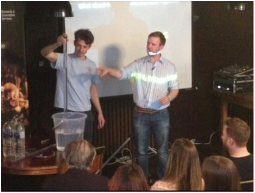 A volcanic gas slug with daughter bubbles. The conduit is 4 m wide. With gridded area representing computational mesh of a quarter of a pipe. A volcanic gas slug with daughter bubbles. The conduit is 4 m wide. With gridded area representing computational mesh of a quarter of a pipe. Myself, along with a number of other authors in Sheffield, Lancaster, Palermo, and Florence have just published a paper in the journal Geophysical Research Letters called "Conduit dynamics and post explosion degassing on Stromboli: A combined UV camera and numerical modeling treatment". This paper is full Open Access which means that anyone can download and distribute the paper which is absolutely great! This work combines a large number of ultra violet camera based observations of sulphur dioxide release during and following strombolian explosions (which is called a gas flux trace) and smaller degassing events not necessarily associated with ejectiles (i.e. any magma release). Within the paper these are referred to as Vent 1 and Vent 2 events respectively. The benefit of collecting such a large number of gas flux traces is that any trends present or common characteristics between differing events can be compared. This allowed six flux trace types to be identified based on the patterns in gas release following the initial impulsive event associated with a strombolian explosion or smaller degassing event. Following on from this, building on the work of Tamburello et al. (2012) who noticed that gas flux traces from strombolian explosions contained a coda (a period of elevated flux before a return to background levels), we were able to approximately separate out the distribution of gas mass into the initial impulsive gas release and the resultant coda. This allowed us to determine that a large proportion of the entire event (i.e. the initial release of gas added to the coda) could be contained within the coda - quite an interesting observation! Alongside this work we performed a number of computational fluid dynamics simulations (using Ansys Fluent) of gas slug flow (Taylor bubble - see previous post). Over a range of parameters for the magma density, viscosity, and the conduit diameter we discovered that it was possible for the simulated gas slugs to shed gas bubbles, called "daughter bubbles", from the base of the slug at varying rates of efficiency. If these slugs were to rise over extended distances (simulations in the manuscript were over short distances in comparison to a full volcanic conduit) then significant mass could be lost from the slug into a daughter bubble train and contribute to the observed gas coda. There are of course other possibilities for the coda generation, however, daughter bubble could certainly play a role in determining how explosive an event may become and has wider implications for activity at other volcanoes. This is the first study to combine gas flux measurements with computational fluid dynamics models. For full details you will of course have to read the paper! Associated videos are also available. References Pering, T. D., A. J. S. McGonigle, M. R. James, G. Tamburello, A. Aiuppa, D. Delle Donne, and M. Ripepe (2016), Conduit dynamics and post explosion degassing on Stromboli: A combined UV camera and numerical modeling treatment,Geophys. Res. Lett., 43, doi:10.1002/2016GL069001. Tamburello, G., A. Aiuppa, E. P. Kantzas, A. J. S. McGonigle, and M. Ripepe (2012), Passive vs. active degassing modes at an open-vent volcano (Stromboli, Italy), Earth Planet. Sci. Lett., 359–360, 106–116.  Demonstrating slug flow live. Demonstrating slug flow live. Last night I gave my Pint of Science talk in Sheffield and hopefully those who came learnt a thing or two about bubbles and their role in driving volcanic eruptions! My talk gave an overview of the range of activities that I study, from passive degassing through to lava fountaining, with a major focus on strombolian eruptions. In particular I discussed the role of volcanic gas slugs in generating such eruptions and some of the features which we have discovered during the course of my research at the University of Sheffield, including: past work at Etna which provided the first potential evidence for coalescence of gas slugs during volcanic activity, recent work just published in Geophysical Research Letters on the combination of gas measurements with computational models which demonstrated the possibility of daughter bubble production (the release of gas bubbles from the base of a slug) and that this could essentially cause slugs to destroy themselves (I will blog on this work soon), finally I introduced work I presented at AGU in 2014 which we are currently writing up for publication on laboratory and computational experiments conducted into multiple slug flow. The journey of Bob the Bubble proved to be a popular addition to my talk, raising a few chuckles (video below). Bob the Bubble illustrates the journey of a gas bubble from a magma chamber, through a conduit and the shape (morphology) transitions which may occur throughout ascent. As part of my talk I also performed a few short demonstration experiments (see photo) on the coalescence of smaller bubbles to make a cap bubble, through to an ascending slug. With the kind assistance of Tom Wilkes we even managed to demo a series of slug coalescence events which worked perfectly on the first try. This was rather fortuitous as it didn't really work during testing on the previous day! Dr Ed Daw of LIGO heritage spoke after my talk and gave some fascinating insights into the science and what it really took to detect gravity waves! He also hinted that further discoveries may be coming soon... A very enjoyable event which it was a pleasure to be a part of. A big up to all the volunteers who made this event happen in Sheffield!  A variety of bubble shapes which may be found within magmas. Taken from my thesis: Pering, 2015. A variety of bubble shapes which may be found within magmas. Taken from my thesis: Pering, 2015. Over the past 3 years I have delved into a large variety of topics in varying arrays of detail. However, a major theme throughout my work has been the investigation into the fluid dynamics of bubbles, and in particular a feature known as a Taylor bubble (or gas slug) e.g.Wallis (1969) and Bendiksen, (1985). Increasing mass and/or volume of a bubble its shape will naturally change, from a spherical bubble (Wegener and Parlange, 1973) to one that may elongate or deform, through to a cap bubble and then the Taylor bubble. The Figure on the right hand side illustrates this nicely. One of the major activities driven by the Taylor bubble is strombolian volcanism, be it that related to single events (as at Stromboli) or more rapid events, as I have previously observed at Etna. The Taylor bubble has a number of predictable parameters, including: the distances between the wall and the Taylor bubble edge (termed the falling film), the rise speed of the base of the Taylor bubble, and certain lengths associated with the passage of the bubble - the wake and interaction lengths (Campos and Guedes de Carvalho, 1988). In addition there are a number of dimensionless numbers which help characterise the behaviour of a gas bubble within a fluid, e.g. Reynolds, Morton, Eotvos, and Weber numbers. Within volcanology one area of focus is on the determination of the masses of these Taylor bubbles (i.e. using ultra-violet cameras), which can then be used to work out final lengths and possible burst pressures of the bubbles. All of these parameters above require a set of distinct equations to calculate, which, can sometimes be difficult to locate. There are very few (in fact I didn't find any) resources available online for the calculation of many of these parameters and their calculation often involves the loading up of software such as Matlab. It is for these reasons that I have created an online calculator to enable the calculation of a range of useful (to me and hopefully to others!) dimensionless numbers and Taylor bubble related features. This resource is available here, and for the moment I have called it the "Slug Calculator". It is currently split into two sections. The first "Dimensionless Numbers and Taylor Bubble Parameters" essentially allows the calculation of parameters related to the section title, while the second "Taylor Bubble Mass and Length Inputs/Results" uses pressure, temperature, mass and ratio values (of the common volcanic gases) to estimate a variety of potentially important Taylor Bubble parameters. The calculator is a work in progress, so will be improved and altered as I notice errors or learn how to make improvements! References Bendiksen, K. H., 1985. On the motion of long bubbles in vertical tubes. International Journal of Multiphase Flow 11 (6), 797-812, doi:10.1016/0301-9322(85)90025-4 Campos, J. B. L. M., Guedes de Carvalho, J. R. F., 1988. An experimental study of the wake of gas slugs rising in liquids, Journal of Fluid Mechanics 196, 27-37, doi:10.1017/S0022112088002599 Pering, 2015. Bubbles in Basalts: Measuring and Modelling Basaltic Degassing. PhD Thesis, 2015. University of Sheffield. Wallis, G. B., 1969. One-dimensional two-phase flow. New York, NY: McGraw-Hill Wegener, P. P., Parlange, J. Y., 1973. Spherical-Cap Bubbles. Annual Review of Fluid Mechanics 5, 79-100. doi:10.1146/annurev.fl.05.010173.000455  This year Pint of Science is coming to Sheffield. I will be in esteemed company with Dr Ed Daw who will be talking about gravitational waves detected as part of the LIGO experiment in a combined event called Ripples and Bangs. I will of course be contributing the "Bangs" part of the event - where I will discuss my previous, ongoing and future research into the behaviour of bubbles at basaltic volcanoes. Volcanic eruptions are one of the most spectacular phenomena we see on this planet. Through the medium of beer, I will explain the journey of the gas bubbles which drive these eruptions, from birth, to eruption at the surface. I will explore how we investigate these bubbles, by using state-of-the-art monitoring equipment to measure gas output and computer models to simulate gas flow. Fully unlocking the secrets of this journey is an essential future goal in volcanology, where any progress made will play a key part in aiding eruption forecasting. This is a ticketed event on the 25th May 2016 in Bloo 88, tickets are available for purchase here. |
Archives
July 2023
|

 RSS Feed
RSS Feed